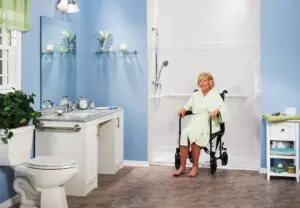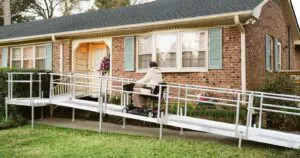A bathroom remodel does more than update tile and fixtures; it can transform daily life for older adults. An optimized bathroom helps seniors stay independent, lowers the risk of slips and falls, and creates a more comfortable, dignified space.
Atlas Home Safety is dedicated to delivering safe bathing options for seniors tailored to individual needs. From low-threshold walk-in showers to fully barrier-free designs and therapeutic walk-in tubs, today’s options balance safety with style.
In this guide, you’ll find practical comparisons, key safety features, and tips to choose the solution that best fits your needs and budget.
Quick Match: Safe Bathing Options for Seniors by Mobility Needs
- Low-Threshold Walk-In Shower (≤ 3″) – Best for mild mobility limits and those who prefer showering.
- Barrier-Free / Curbless Shower (0–1¼”) – Ideal for wheelchair or walker users who need zero-step entry.
- Walk-In Bathtub (Soaker, Air, Whirlpool, Combo) – Great for seniors who love soaking and want therapeutic jets.
- Tub/Shower Combo with Safety Upgrades – Works if you must keep a tub; add a cut-out or transfer bench for easier, safer bathing.
Shower Options for Older Adults
1) Low-Threshold Walk-In Showers
Walk-in showers (≤ 3″) are great if you can still step but want a much lower entry. The reduced threshold cuts out the big leg lift of a traditional tub, and pairing it with a fold-down seat or sturdy shower chair lets you bathe seated. Add a vertical grab bar at the entry and a horizontal bar along the long wall, and choose a textured pan or anti-slip coating. Installation is typically faster than curbless and fits many bathrooms, but it isn’t roll-in and still leaves a small step.
2) Barrier-Free / Curbless (Roll-In) Showers
Barrier-free showers (≤ 1¼”, often zero-entry) are best for wheelchairs, walkers, and changing mobility. With no step, transfers and assisted bathing are simpler and safer. Success depends on precise floor slope to a linear drain, smart splash control with fixed glass and pan sizing, and meticulous waterproofing—this is pro work. You get maximum accessibility and easy cleaning, with the tradeoff of floor regrading and a higher upfront cost.
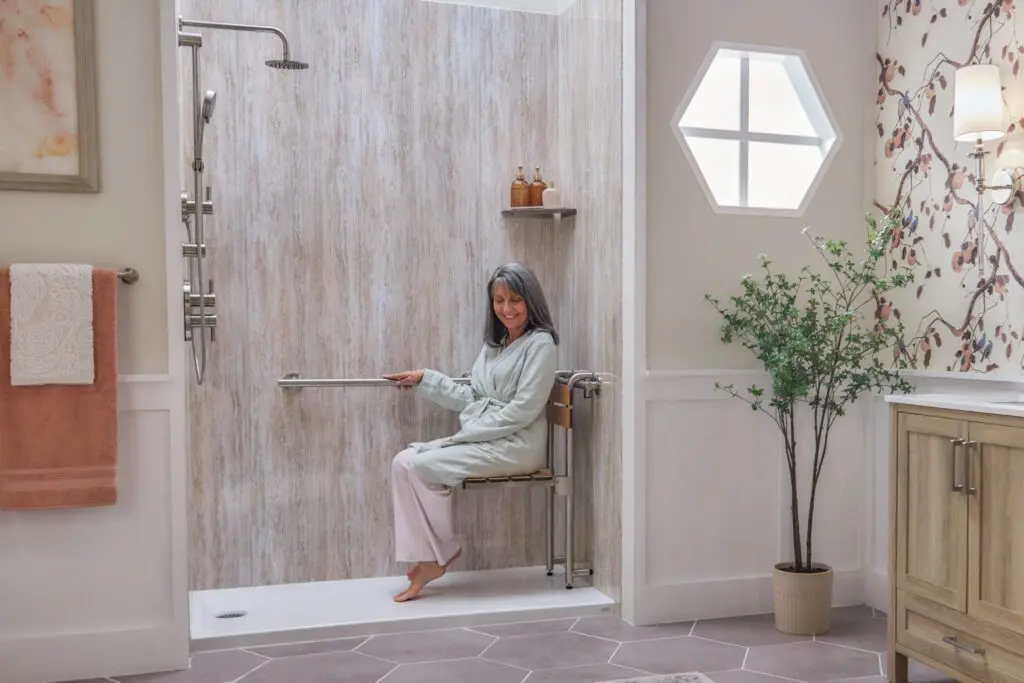
3) Enclosed Walk-In Showers (Glass Two-Wall Enclosures)
Choose this when you want strong splash control and a design statement. Frameless glass on two sides keeps water in and sightlines open; pick a swing or sliding door based on your space. Size the door handle for an easy grip, but rely on real grab bars for support.
4) Doorless / Panel-Style Showers (One Fixed Glass Panel)
A single fixed panel keeps things simple and low-maintenance, especially in smaller rooms. Lengthen the pan and aim the showerhead thoughtfully to minimize overspray.
Keeping a Tub? Safer Step-In Bathing Inside a Combo
If a full conversion isn’t in the cards, you can still bathe safely in a tub/shower. Lower the step with a tub cut-out, slide in on a transfer bench to stay seated while you shower, and use properly mounted grab bars plus a long-hose handheld for control and comfort.
In-Shower Safety & Comfort Features (Pair With Any Shower)
- Seating: Built-in benches (match wall panels), fold-down seats, or shower chairs. Check weight ratings and drainage holes.
- Grab Bars: Vertical at the entry; horizontal along the long wall (typically 33–36″ to top). Mount into studs or with rated anchors.
- Slip Resistance: Textured shower pans or anti-slip coatings; non-slip mat right outside the threshold.
- Handheld Showerhead: Long hose; mount within reach of the seat.
- Anti-Scald / Thermostatic Valves: Prevent temperature spikes; crucial for sensitive skin.
- Control Placement: Reachable from seated position and near entry so you can turn water on/off without standing in the spray.
- Recessed Niches: Storage that won’t protrude into the path of travel.
Bathtub Options for Older Adults
Walk-In Bathtubs: Core Safety Anatomy
A walk-in tub swaps the risky tub wall for a low threshold and watertight door, so you step in instead of climbing over. The higher built-in seat is easier on knees and hips and makes transfers simpler, while a textured floor, integrated grab bars, easy-reach controls, and anti-scald protection keep bathing steady and comfortable. Before you buy, check door swing clearance (out-swing styles need extra room), ask about real-world fill/drain times so you’re not cooling off while you wait, and confirm your water heater can keep up with the larger volume.
Types of Walk-In Tubs
- Soaker: Quiet, simplest maintenance.
- Air-Jetted: Gentle, full-body bubbles; easier cleaning than water jets.
- Whirlpool (Water-Jetted): Deep-tissue massage for sore joints/muscles.
- Combo Air + Water: Tunable therapy; most versatile.
- Wheelchair-Accessible/Slide-In: Wider door, internal transfer seat; minimal pivoting.
Comfort Upgrades
Look for heated backrests and seats, an inline heater to maintain water temperature, rapid fill/drain hardware to cut wait times, and contoured backrests with supportive neck pillows to extend comfortable soak time.
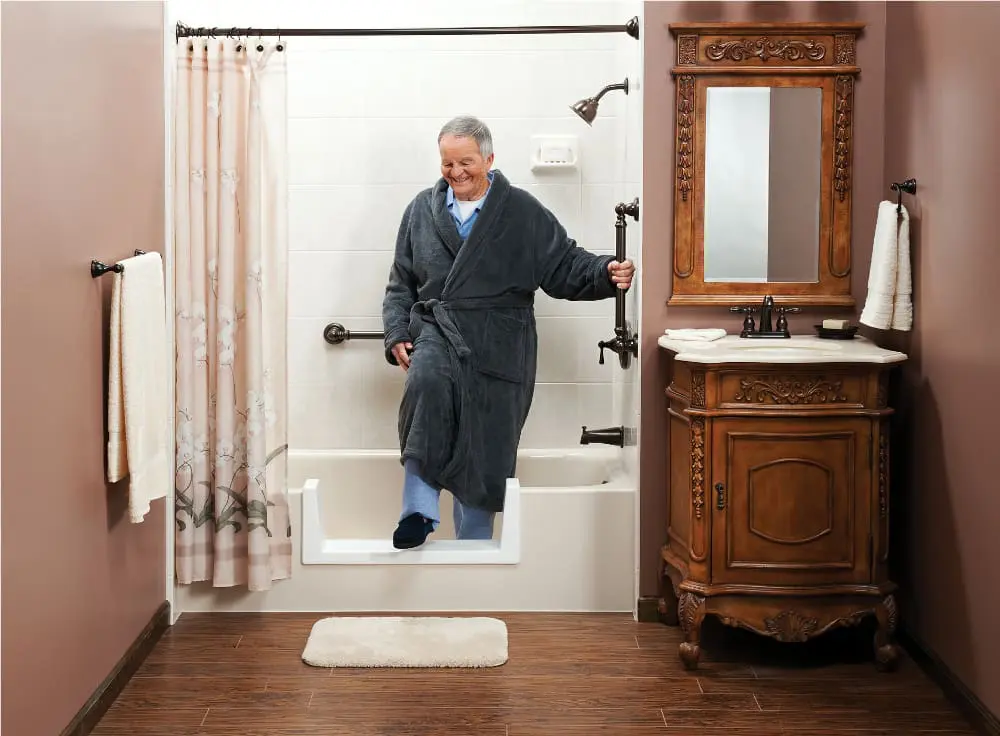
Layout for Independence and Assisted Bathing
Treat the shower like a small workspace: keep a wide, curbless entry and open “landing zones” so turns and transfers are easy. Place the seat where the spray reaches comfortably and the controls are within arm’s reach, and preserve dignity with simple privacy touches like a lap towel and frosted or strategically placed glass.
Installer / Vendor Questions to Ask
- Threshold height (exact measurement) and pan slip resistance rating.
- Seat type and load rating; grab bar anchoring method (studs, blocking, or rated anchors).
- Valve type (thermostatic/pressure-balance) and maximum temp limit.
- Drainage plan (slope, linear drain spec) for curbless; waterproofing system used.
- Glass: door swing/clearance, handle design, and safety film options.
- Walk-in tub: fill/drain rates, heater requirements, service access, and warranty.
- Maintenance: recommended cleaners, gasket care (for jets/doors), and service intervals.
Comparison Table (Copy/Paste Friendly)
| Option | Best For | Entry Height | Wheelchair Friendly | Needs Seat? | Key Safety Features | Install Complexity | Maintenance Notes |
| Low-threshold walk-in shower | Mild mobility limits | ≤ ~3″ | ◻︎ | ✓ recommended | Textured pan, grab bars, handheld, anti-scald valve | Medium | Simple surfaces if using wall panels |
| Barrier-free/curbless shower | Wheelchairs/walkers; long-term aging | 0–1¼” | ✓ | ✓ | Zero step, linear drain, robust waterproofing, grab bars | Higher | Keep drains clear; inspect caulk/membranes |
| Enclosed walk-in (glass) | Splash control + style | ≤ ~3″ (varies) | ◻︎ | ✓ | Stable door hardware, textured pan, anti-scald | Medium–High | Glass care; hinge maintenance |
| Doorless/panel-style | Low maintenance, fewer moving parts | ≤ ~3″ or 0″ | ◻︎/✓ (depends on pan) | ✓ | Slope + panel splash control, grab bars | Medium–High | Minimal hardware upkeep |
| Walk-in tub (soaker) | Soakers who want safety | Low step (door) | ◻︎ | Built-in | Seat height, textured floor, anti-scald | Medium | Clean seals; routine tub care |
| Walk-in tub (air/whirlpool/combo) | Therapeutic hydrotherapy | Low step (door) | ◻︎ | Built-in | As above + jets; consider rapid fill/drain | Medium | Follow jet sanitation schedule |
| Tub/shower combo + transfer aids | Must keep tub, need safer bathing now | 14–18″ typical (lower with cut-out) | ◻︎ | ✓ bench | Transfer bench, vertical entry bar, handheld | Low–Medium | Inspect bench feet and grab bar mounts |
How to Use This Guide in Your Remodel Plan
- Pick the fixture category that matches mobility and preferences (low-threshold shower, curbless shower, or walk-in tub).
- Layer in in-shower safety: seat, grab bars, anti-slip, handheld, anti-scald.
- Confirm fit, drainage, and waterproofing details before you sign.
- Align expectations on fill/drain time (tubs) and floor regrade (curbless).
- Schedule maintenance touchpoints (caulk, gaskets, jet sanitation where applicable).
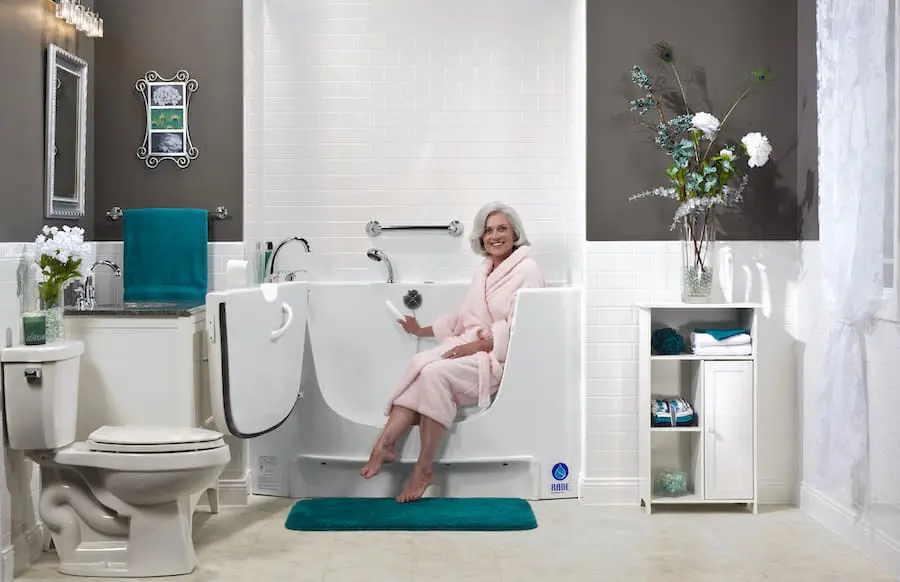
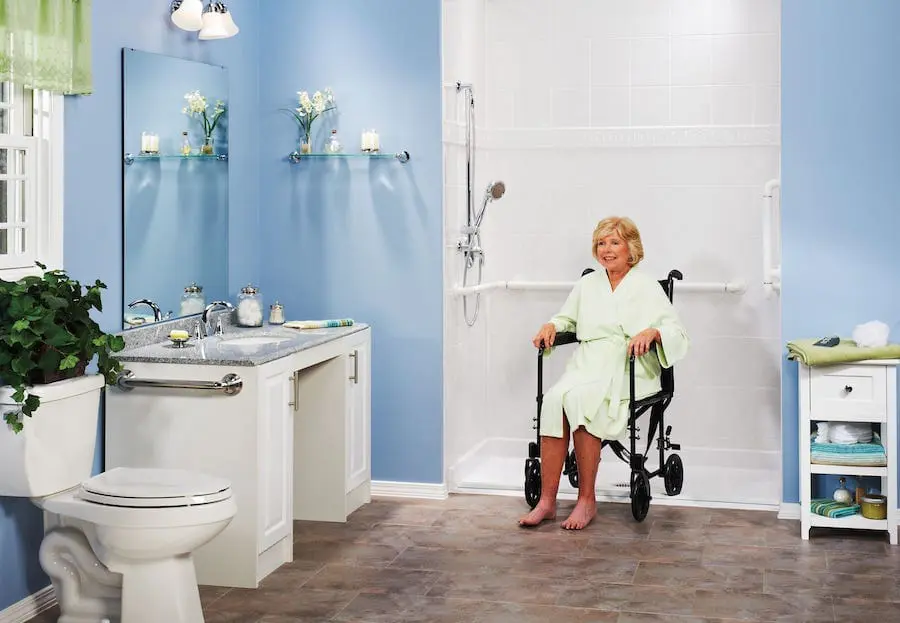
Ready to Upgrade Your Bath or Shower? Take the Next Step With Atlas
Choosing the right bathing setup isn’t about picking a trendy fixture—it’s about matching real mobility needs with a shower or tub that’s safe, comfortable, and easy to use every single day.
If you’re in Southeast Michigan, Atlas Home Safety can help you turn this guide into a plan that fits your space, budget, and timeline.
Ready to make bathing safer and more comfortable at home? Reach out to Atlas Home Safety by filling out a contact form to get started.
FAQs: Safe Bathroom Options for Seniors
Will a curbless shower leak?
Not when designed correctly. The pan is sloped to a linear drain, splash is controlled with glass placement, and the entire area is waterproofed beneath the finish surfaces.
Are frameless glass enclosures safe for seniors?
Yes—when paired with true grab bars on the walls. Door handles are for doors, not for bearing weight.
Do I really need an anti-scald valve?
Strong yes. Thermostatic or pressure-balance valves stabilize temperature and reduce burn risk—especially important for thinner, sensitive skin.
How long do walk-in tubs take to fill and drain?
It varies by model and plumbing. Ask for fill/drain rates and consider rapid-drain and inline heaters so water stays comfortable.
Can I add a seat later?
Often, yes. Many walk-in showers accept fold-down seats or sturdy shower chairs. It’s smart to install blocking in walls during any remodel to future-proof for seats and bars.
What’s the smallest change that makes bathing safer?
In an existing shower/tub: grab bars + handheld shower + non-slip surface + seat. Those four upgrades dramatically lower the risk during real bathing.





